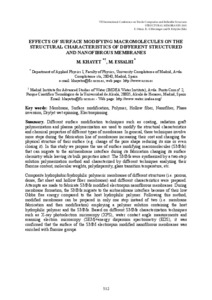Mostra el registre d'ítem simple
Effects of surface modifying macromolecules on the structural characteristics of different structured and nanofibrous membranes
| dc.contributor.author | Khayet, M. |
| dc.date.accessioned | 2017-10-30T11:20:16Z |
| dc.date.available | 2017-10-30T11:20:16Z |
| dc.date.issued | 2015-10-19 |
| dc.identifier.isbn | 978-94-944-244-8-9 |
| dc.identifier.uri | http://hdl.handle.net/2117/109387 |
| dc.description.abstract | Different surface modification techniques such as coating, radiation graft polymerization and plasma polymerization are used to modify the structural characteristics and chemical properties of different types of membranes. In general, these techniques involve more steps during the fabrication line of membranes increasing their cost and changing the physical structure of their surface (e.g. change of the pore shape reducing its size or even closing it). In this study we propose the use of surface modifying macromolecules (SMMs) that can migrate to the air/membrane interface during its fabrication changing its surface chemistry while leaving its bulk properties intact. The SMMs were synthesized by a two-step solution polymerization method and characterized by different techniques analyzing their fluorine content, molecular weights, polydispersity, glass transition temperature, etc. Composite hydrophobic/hydrophilic polymeric membranes of different structures (i.e. porous, dense, flat sheet and hollow fiber membranes) and different characteristics were prepared. Attempts are made to fabricate SMMs modified electrospun nanofibrous membranes. During membrane formation, the SMMs migrate to the air/membrane interface because of their low Gibbs free energy compared to the host hydrophilic polymer. Following this method, modified membranes can be prepared in only one step instead of two (i.e. membrane fabrication and then modification) employing a polymer solution containing the host hydrophilic polymer and the SMMs. Based on different SMMs characterization techniques such as X-ray photoelectron microscopy (XPS), water contact angle measurements and scanning electron microscopy (SEM)+energy dispersion spectrometry (EDS), it was confirmed that the surface of the SMM electrospun modified nanofibrous membranes was enriched with fluorine groups. |
| dc.format.extent | 12 p. |
| dc.language.iso | eng |
| dc.publisher | CIMNE |
| dc.subject | Àrees temàtiques de la UPC::Matemàtiques i estadística::Anàlisi numèrica::Mètodes en elements finits |
| dc.subject.lcsh | Finite element method |
| dc.subject.lcsh | Air-supported structures |
| dc.subject.other | Membrane |
| dc.subject.other | Surface modification |
| dc.subject.other | Polymer |
| dc.subject.other | Hollow fiber |
| dc.subject.other | Nanofiber |
| dc.subject.other | Phase inversion |
| dc.subject.other | Dry/jet wet spinning |
| dc.subject.other | Electrospinning |
| dc.title | Effects of surface modifying macromolecules on the structural characteristics of different structured and nanofibrous membranes |
| dc.type | Conference lecture |
| dc.subject.lemac | Estructures pneumàtiques |
| dc.rights.access | Open Access |
| local.citation.contributor | Structural Membranes 2015 |
| local.citation.pubplace | Barcelona |
| local.citation.publicationName | Textiles composites and inflatable structures VII : proceedings of the VII International Conference on Textile Composites and Inflatable Structures, Barcelona, Spain. 19-21 October, 2015 |
| local.citation.startingPage | 512 |
| local.citation.endingPage | 523 |


